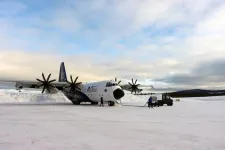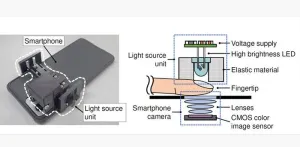(Press-News.org) WASHINGTON – U.S. Naval Research Laboratory (NRL) research meteorologist James Doyle, Ph.D., joins an international team of scientists to investigate meteorological processes associated with Arctic cold air outbreaks.
From late February through early April, the 45-day international field campaign CAESAR, short for Cold-Air outbreak Experiment in the Sub-Arctic Region, is focused on cold-air outbreaks that occur as cold Arctic air flows-out over warmer open waters between northern Norway and the Arctic ice edge.
Cold-air outbreaks, or CAOs -- one of the most extreme meteorological air mass transformations on Earth -- can occur when cold Arctic air flows over frozen land masses or sea ice to over much warmer open ocean waters resulting in the formation of convective boundary layers that produce hazardous winds and seas, and spawn small-scale, intense “polar lows.”
“Despite the profound impact that CAOs have on atmospheric and oceanic circulations in the Arctic, as well as the important implications for Navy operations, surprisingly little is known about the nature of intense surface flux impacts on the atmosphere and ocean boundary-layer structure,” said Doyle. “The nature of the air-sea-ice interaction and cloud processes in CAOs are rapid with abrupt transitions, which have been a roadblock to process understanding and model predictions.”
CAOs pose challenges to Navy operations because of the severe environmental conditions and the rapid changes in the atmosphere and ocean boundary layer properties that impact electromagnetic and acoustic propagation characteristics. The CAESAR mission seeks to investigate the marine atmospheric boundary layer characteristics and shallow, precipitating clouds that form during CAOs, as well as the mesoscale circulations that lead to polar low developments.
“Under favorable conditions the air-sea interaction intensifies, triggering shallow and vigorous convective cells that produce hazardous winds and seas, and under some conditions lead to the genesis of small-scale, intense polar lows,” said Doyle. “Conventional theories and model parameterizations in Arctic CAOs have been lacking this vital data and CAESAR will provide a detailed characterization that will form the basis for NRL boundary layer and coupled modeling studies.”
Based in Kiruna, Sweden, the CAESAR team will utilize the National Science Foundation (NSF)/National Center for Atmospheric Research (NCAR) center’s C-130 Hercules aircraft, with in situ and remote sensors and dropsondes for sampling the Arctic air mass -- from the CAO origin at the ice edge through the transformation -- as the boundary layer gets modified downstream. The C-130 suite of instruments also include airborne radar, LiDAR, and aerosol and cloud precipitation probes activated during CAO events.
CAESAR will also make use of Norwegian ground-based radars and instruments located on Norway’s Bear Island.
About the U.S. Naval Research Laboratory
NRL is a scientific and engineering command dedicated to research that drives innovative advances for the U.S. Navy and Marine Corps from the seafloor to space and in the information domain. NRL is located in Washington, D.C. with major field sites in Stennis Space Center, Mississippi; Key West, Florida; Monterey, California, and employs approximately 3,000 civilian scientists, engineers and support personnel.
For more information, contact NRL Corporate Communications at (202) 480-3746 or nrlpao@us.navy.mil.
END
NRL participates in international campaign investigating polar low phenomena
2024-03-08
ELSE PRESS RELEASES FROM THIS DATE:
Are mountains carbon dioxide sources or sinks? New study finds they can be both
2024-03-08
There’s been a long-running debate in Earth sciences over whether mountains are a source of carbon dioxide or if they remove carbon dioxide from the atmosphere through mineral weathering. A new study has found that mountains can be sources or sinks and has identified the tipping point at which they switch from one to the other.
The study — by Ludwig Maximilian University of Munich, Colorado State University and the German Research Centre for Geosciences — found that many mountains exist on a spectrum of removing or releasing carbon, and erosion rates determine the impact of mountains ...
Child care costs, availability keeping New York parents at home, poll finds
2024-03-08
BUFFALO, N.Y. - Two out of five New Yorkers with children who participated in a recent poll report that a member of their household opts not to work, mostly because child care is too expensive, while child care workers earn among the lowest wages in the state, according to a report released March 8 by the Cornell School of Industrial and Labor Relations Buffalo Co-Lab.
Continuing a multiyear effort with collaborators to determine the “true” cost of child care, “The Status of Child Care in New York State” finds that recent increases in state subsidies helped stabilize ...
Blood pressure control in veterans declined during the COVID-19 pandemic
2024-03-08
A multi-institution team led by researchers at the White River Junction VA Medical Center in Vermont found that Veterans’ blood pressure control worsened due to disrupted care during the COVID-19 pandemic. The findings were published in the journal Medical Care.
The researchers followed a group of nearly 1.65 million Veterans who received their care at VA and who had high blood pressure (hypertension) during two periods—before the pandemic and during the pandemic. In Veterans with controlled blood pressure, researchers found a 7% decline in control during the pandemic compared ...
Lighting the way to noninvasive blood glucose monitoring using portable devices
2024-03-08
Diabetes is a very prevalent disease that, unfortunately, still has no treatment. People with diabetes need to monitor their blood glucose levels (BGLs) regularly and administer insulin to keep them in check. In almost all cases, BGL measurements involve drawing blood from a fingertip through a finger prick. Since this procedure is painful, less invasive alternatives that leverage modern electronics are being actively researched worldwide.
Thus far, several methods to measure BGL have been proposed; using infrared light is a prominent example, and mid-infrared light-based devices have shown reasonable performance. However, the required sources, ...
What's behind the surge of fatty liver disease in Latinx kids?
2024-03-08
For Latinx kids, unreliable access to food at age 4 raises the odds of having fatty liver disease later in childhood by nearly four times, a new UC San Francisco-led study found.
About 5% to 10% of children in the United States have nonalcoholic fatty liver disease, putting its prevalence on par with asthma. Pediatric cases have spiked in the last decade, with millions now affected by a disease marked by pain, fatigue and jaundice that can lead to cirrhosis, cancer and organ transplantation. Latinx children and adults ...
nTIDE February 2024 Jobs Report: Overall employment trend still positive despite recent declines for people with disabilities
2024-03-08
East Hanover, NJ – March 8, 2024 – Despite recent declines in the labor force participation rate and employment-to-population ratio, the overall employment trend remains positive for people with disabilities, according to today’s National Trends in Disability Employment – semi-monthly update (nTIDE), issued by Kessler Foundation and the University of New Hampshire’s Institute on Disability (UNH-IOD).
Month-to-Month nTIDE Numbers (comparing January 2024 to February 2024)
Based on data from the U.S. Bureau of Labor Statistics ...
Locating single neurons that monitor and regulate the heart and lungs
2024-03-08
The body self-regulates in a process known as homeostasis, and the brain is responsible for this
as it is constantly monitoring all of the body’s vital signals. If you need more oxygen, for
example, then a message is sent to the brain that then tells the body to adjust your breathing
and your heart rate. But the neurons involved in regulating breathing and cardiac rhythm had
never been directly observed, until now, thanks to brain recording technology during brain
surgery.
EPFL neuroscientists, in a collaboration with surgeons and neuroscientists at West Virginia
University Rockefeller Neuroscience ...
Primary care scarcity linked to more surgical emergencies & problems
2024-03-08
America’s shortage of primary care doctors and nurse practitioners has a downstream effect in the nation’s operating rooms, a new study finds.
And patients suffer as a result.
In all, people living in areas with the most severe shortages of primary care providers have a much higher risk of having emergency surgery, rather than a scheduled operation,
compared with people with the same condition who live in areas with less-dire primary care shortages.Those living in the areas with the lowest availability of primary care providers ...
Novel PET tracer maps fructose metabolism to identify cardiac and neural disorders
2024-03-08
Reston, VA—A new PET radiotracer can differentiate diseased tissues from healthy tissues based on fructose metabolism, according to new research published in the March issue of The Journal of Nuclear Medicine. Fructose metabolism—or fructolysis—is indicative of a variety of diseases, and by noninvasively mapping fructolysis physicians can more accurately detect diseases and treat them earlier.
Glucose is used as the primary biochemical fuel throughout the body, powering key processes like tissue function, growth, and repair. Glucose is also consumed extensively during inflammation and cancer growth and can be visualized with PET scans. Evidence continues to mount that ...
Pushing the boundary on ultralow frequency gravitational waves
2024-03-08
A team of physicists has developed a method to detect gravity waves with such low frequencies that they could unlock the secrets behind the early phases of mergers between supermassive black holes, the heaviest objects in the universe.
The method can detect gravitational waves that oscillate just once every thousand years, 100 times slower than any previously measured gravitational waves.
“These are waves reaching us from the farthest corners of the universe, capable of affecting how light travels,” said Jeff Dror, Ph.D., an assistant ...



